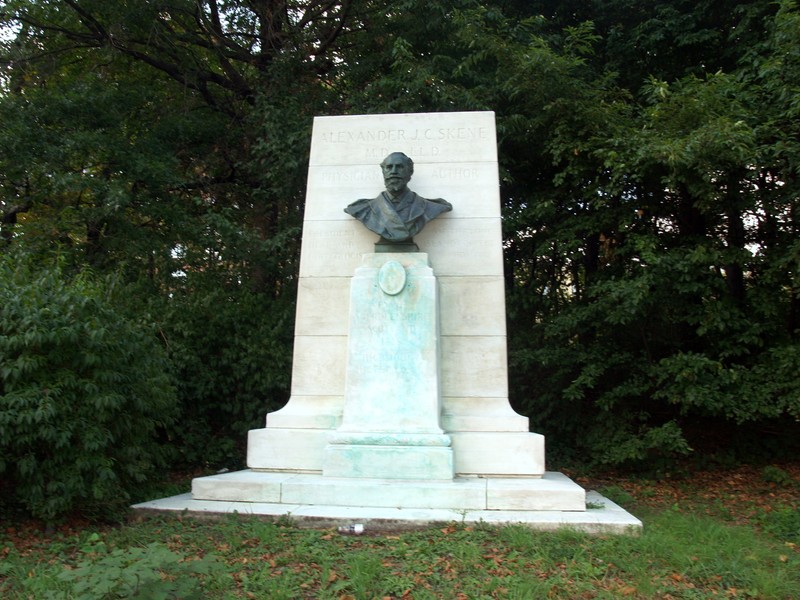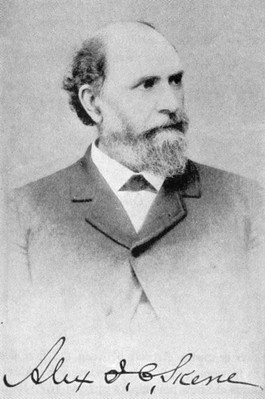Alexander J.C. Skene Monument
Introduction
Text-to-speech Audio
Images
Alexander J.C. Skene Monument in Grand Army Plaza

Alexander J.C. Skene (1838-1900)

Backstory and Context
Text-to-speech Audio
Alexander Johnston Chalmers Skene was born in the small village of Fyvie in Aberdeenshire, Scotland on June 17, 1838. He attended King’s College in London before immigrating to Canada, where he settled in Toronto and began studying medicine. Skene then immigrated to the United States and continued his medical studies at the University of Michigan. After a short time in Ann Arbor, he moved to Brooklyn, where he finally earned his medical degree from the Long Island College Hospital (now the State University of New York Downstate Medical Center) in 1863.
At the time, the country was embroiled in the Civil War. After graduation, Skene served for nearly a year as an assistant surgeon in the Union Army, during which time he was stationed in South Carolina and New York. Once out of the military, he settled in Brooklyn and established a private medical practice. Sometime after, Skene began teaching part-time at the same place he earned his medical degree, Long Island College Hospital. In 1870, he received a promotion to Professor of Diseases of Women and Clinical Obstetrics, a position he would occupy for nearly three decades. In addition to holding his faculty position, Skene served as the college’s Dean of Faculty from 1886 to 1893 and its president from 1893 to 1899.
Skene was a prolific, internationally renowned physician and researcher who helped to establish the specialties of obstetrics and gynecology. In the course of his career, he published over one hundred scholarly articles and a handful of textbooks. Today, Skene is best known for his discovery of the para-urethral glands in the female genitalia, which were later named in his honor. In the late 1880s, Skene helped to found the American Gynecological Society, the first national organization in the world devoted to obstetrics and gynecology.
Outside of medicine, Skene devoted considerable time to various artistic pursuits. He dabbled in sculpture and even published a Victorian romance novel. A bust he created of friend and fellow physician, J. Marion Sims, resides in the Medical Society of the County of Kings. Skene died at his vacation home in the Catskill Mountains on July 4, 1900, just weeks after celebrating his sixty-second birthday.
Following Skene’s death, his colleagues at Long Island College Hospital formed a committee and began raising funds to erect a monument in his honor. The committee commissioned artist John Massey Rhind and architects M.L. and H.G. Emery to construct the monument, and selected Brooklyn’s Prospect Park as the appropriate site for its location. Dedicated in 1905 in Grand Army Plaza, the monument features a larger-than-life-sized bronze bust of Skene, dressed in a suit jacket and tie with an academic robe draping his shoulders. The bust sits atop a truncated Vermont white marble obelisk, which is partially built into a stele made of the same material.
In 2011, the Prospect Park Alliance and the New York City Department of Parks and Recreation announced that the monument to Skene would be moved to accommodate the relocation of the park’s statue of Abraham Lincoln. Residing in Prospect Park’s Concert Grove since the 1890s, the statue of Lincoln will take the place of Skene’s monument in Grand Army Plaza. Consequently, Skene’s monument will be moved to another location within the plaza.
Sources
"Dr. Alexander J.C. Skene." New York City Department of Parks and Recreation. The City of New York. Web. 28 January 2021 <https://www.nycgovparks.org/parks/B040/monuments/1451>.
Hargittai, Istvan and Magdolna Hargittai. New York Scientific: A Culture of Inquiry, Knowledge, and Learning. New York: Oxford University Press, 2017.
Powderly, Kathleen E. "Patient Consent and Negotiation in the Brooklyn Gynecological practice of Alexander J.C. Skene, 1863-1900." Journal of Medicine and Philosophy 25, no. 1 (2000): 12-27.
https://en.wikipedia.org/wiki/Bust_of_Alexander_Skene
https://en.wikipedia.org/wiki/Alexander_Skene
